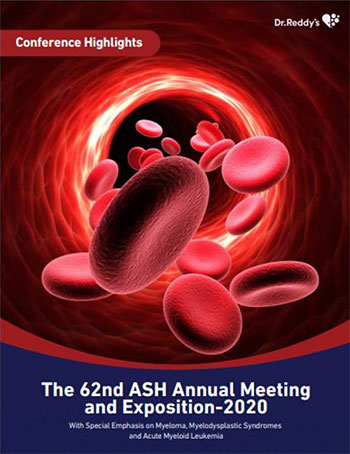
View
Multiple Myeloma
Some Highlighted Studies
Study : Daratumumab Plus Lenalidomide, Bortezomib, and Dexamethasone (RVd) in Patients with Transplant-Eligible Newly Diagnosed Multiple Myeloma: Updated Analysis of GRIFFIN after 12 Months of Maintenance Therapy24
Speaker: Dr. Jonathan L. Kaufman
Background : Daratumumab has been approved as monotherapy and in combination with standard-of–care regimens for relapsed/refractory multiple myeloma and NDMM. It had been observed in phase II GRIFFIN trials in patients with transplant-eligible NDMM that daratumumab plus RVd (D–RVd) improved the rates of stringent complete response (sCR)
Method : Patients with NDMM eligible for high-dose therapy (HDT) and autologous stem cell transplant (ASCT) were randomized 1:1 to RVd ± daratumumab and creatinine clearance rate
Results : After 26.7 months of median follow-up, it was observed that the addition of daratumumab to RVd induction and consolidation, which was followed by D-RVd maintenance improved responses that include higher sCR and MRD negativity rate when compared with lenalidomide alone. There were no new safety concerns in long-term studies.
Study : The Phase 3 TOURMALINE-MM2 Trial: Oral Ixazomib, Lenalidomide, and Dexamethasone (IRd) Vs Placebo-Rd for Transplant-Ineligible Patients with Newly Diagnosed Multiple Myeloma 25
Speaker: Dr. Thierry Facon
Background : In the multicenter, placebo-controlled, double-blind, TOURMALINE-MM2 trial, the efficacy of IRd was compared with placebo-Rd in transplantineligible NDMM patients.
Method : Adult patients with transplant-ineligible NDMM were randomized (1:1) to receive ixazomib (4 mg) or placebo (n=354) on days 1, 8, and 15 of 28- day cycles, and lenalidomide (25 mg) on days 1–21 along with dexamethasone (40 mg) on days 1, 8, 15, and 22. Dexamethasone was discontinued after 18 cycles and treatment continued using ixazomib 3 mg and lenalidomide 10 mg.
Results : IRd was observed to improve the PFS, which is usually poor in expanded high-risk cytogenetics vs. placebo-Rd. No safety concerns were observed making IRd a feasible treatment option for certain patients who can benefit from an all-oral triplet combination.
Study : Treatment of High Risk Smoldering Multiple Myeloma with Carfilzomib, Lenalidomide, and Dexamethasone (KRd) Followed By Lenalidomide Maintenance (-R): A Phase 2 Clinical and Correlative Study 26
Speaker: Dr. Dickran Kazandjian
Background : High-risk smoldering multiple myeloma (HRSMM) often progress within five years to symptomatic MM without therapy. The following study is a single-arm, phase 2 study to determine the rate of MRD negative complete remissions.
Method : Patients with HR-SMM received eight 28-day cycles of carfilzomib 20/36 mg/m2 intravenous on days 1, 2, 8, 9, 15, and 16; lenalidomide 25mg PO on days 1–21; dexamethasone 20/10 mg days 1, 2, 8, 9, 15, 16, 22, and 23. Stem cell collection was done from transplant eligible patients after four cycles of KRd and then treatment was resumed without intent for early high-dose melphalan with stem cell support (HDMASCT). Patients were given maintenance therapy with lenalidomide (10 mg) from days 1–21 for 24 additional cycles after eight cycles of KRd. MM evaluations were performed at the start of every cycle.
Results :Treatment KRd–R in HRSMM patients resulted in an MRD negative CR rate of 70% (median duration of 5.5 years). After five years, only 10% of patients developed MM compared to historical rates in which ~75% of patients develop MM without treatment.













